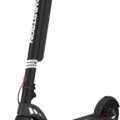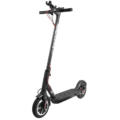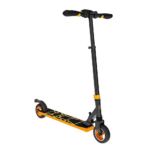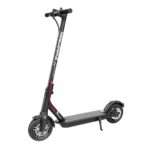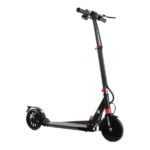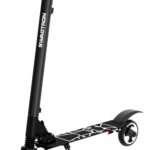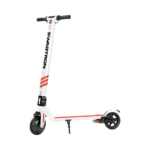- Home
- Scooters
- Electric Scooters
- Swagtron Swagger V1
Swagtron Swagger V1
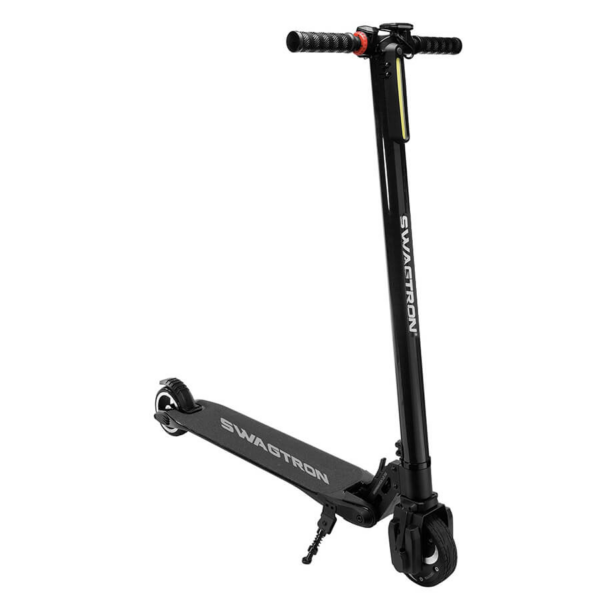

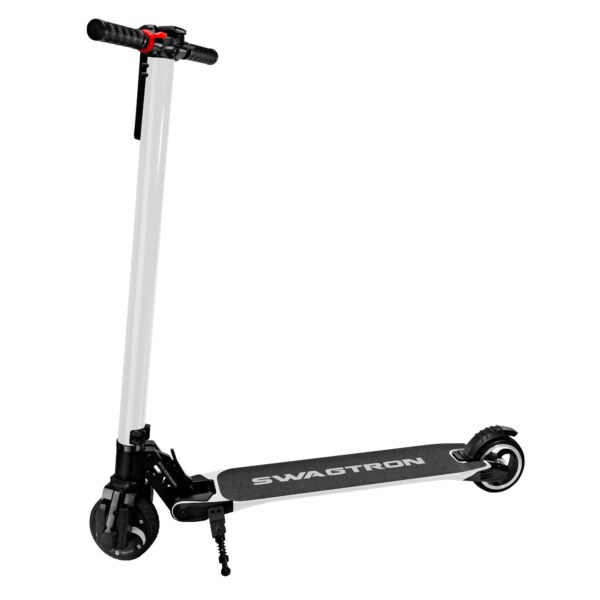
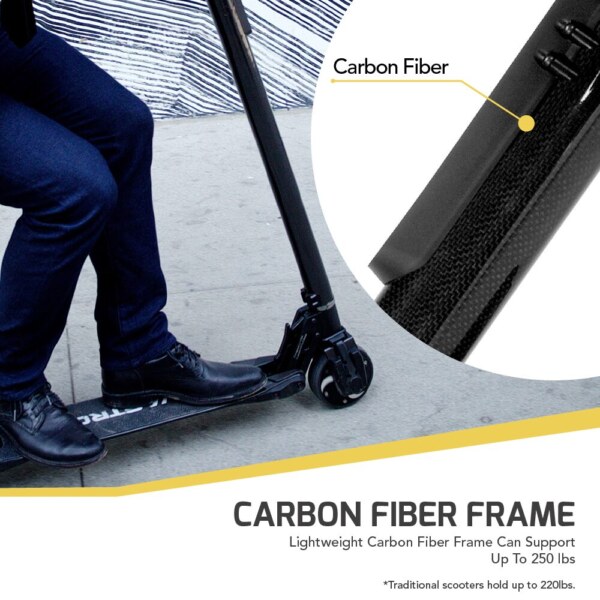
- Battery Range: 4–15 miles (6–24 km)
- Top Speed: 15 mph (24 km/h)
- Motor Power: 250 W
- Weight Capacity: 250 lb (113 kg)
- Charging Time: 1.5 hours
- Scooter Weight: 16.5 lb (7.5 kg)
PROS
- Very light 16.5 lb (7.5 kg) carbon fiber frame for easy carrying
- Compact folded size that fits under desks and in car trunks
- Fast 1.5-hour charge from empty
- 250 lb (113 kg) rider capacity despite low scooter weight
- LED headlight and display with speed and battery indicators
CONS
- Small solid tires transmit bumps and feel harsh on rough pavement
- Limited effective range compared with modern commuter scooters
- No official water-resistance rating
- No Bluetooth app or advanced smart features
Key Takeaways
- The Swagtron Swagger V1 is a lightweight, folding electric scooter designed for short city trips and campus use.
- It features a 250 W front hub motor and a 24 V lithium-ion battery, offering a top speed of around 15 mph (24 km/h).
- Rider limits accommodate users weighing between 44 and 250 lb (20–113 kg) and measuring 4 ft 3 in to 6 ft 6 in tall.
- The scooter excels in portability, weighing about 17 lb (7.7 kg), and charges fully in about 1.5 hours.
- Ideal for students and city dwellers, the Swagtron Swagger V1 is not suited for long, steep hills or rough terrain.
Table of contents
- What Is the Swagtron Swagger V1?
- How the Swagtron Swagger V1 Works
- Key Specifications
- Design & Build Quality
- Performance Fundamentals
- Battery, Range & Efficiency
- Ride Quality & Comfort
- Braking & Safety Features
- Portability & Daily Usability
- Swagtron Swagger V1 vs Alternatives
- Who the Swagtron Swagger V1 Is (and Isn’t) For
The Swagtron Swagger V1 is a tiny, super light folding electric scooter for short city trips and campus runs. It packs a 250 W front hub motor, a 24 V battery, and solid 8.5 in tires into a slim carbon frame. If you care more about low weight and easy folding than brute power or huge range, this little scooter starts to make sense. It feels more like a powered walking helper than a full car replacement.
What Is the Swagtron Swagger V1?
The Swagtron Swagger V1 is a compact adult e-scooter that leans hard into portability. It is often labeled as an ultra light commuter model. You get a narrow deck, a straight stem, folding handlebar grips, and a front wheel that hides the motor inside the hub.
The whole scooter weighs around 17 lb (about 7.7 kg). That number matters, since many bigger commuter scooters land closer to 30 lb (14 kg) or more. So if you live in a walk-up building or hop on buses and trains often, you feel that difference in your arm and in your back.
Rider limits sit in a wide range. The manual targets users between roughly 44 and 250 lb (20–113 kg). It also lists a broad height band from around 4 ft 3 in up to 6 ft 6 in (about 130–200 cm). So the Swagtron Swagger V1 can work for older kids, teens, and many adults, as long as they ride within the weight rating.
You can think of this scooter as a powered last-mile tool. It fits best on smooth bike lanes, campus paths, and city streets that do not beat you up with potholes every ten feet. It does short hops between home, transit stops, and offices quite well. Long suburban drives on rough shoulders sit outside its comfort zone.
Laws around electric scooters change from place to place. So you still need to check what is legal where you live, from helmet rules to sidewalk use and speed limits.
How the Swagtron Swagger V1 Works
At a basic level, the Swagtron Swagger V1 works just like a powered kick scooter. You stand on the deck, hold the bar, and press a thumb throttle on the handle. The front hub motor pulls the scooter forward, and the electronics decide how strong that pull should be.
The motor sits inside the front wheel. It is a brushless DC hub, rated at 250 W. Power comes from a 24 V lithium ion pack hidden in the frame. A small controller lives between the battery and the motor. That controller reads the throttle signal and speed data, then sends current to the motor in short pulses. It keeps an eye on battery voltage and temperature as well.
On the handlebar you get a small backlit LED display. It shows current speed, battery bars, and the speed level you picked. A few buttons let you power the scooter on and off, change modes, and scroll basic info. The interface feels closer to a simple bike computer than to a complex gadget.
The Swagtron Swagger V1 offers five speed levels. The lower ones feel calm and friendly for new riders. You crawl along at walking pace in level 1 and move up to a light jog in level 2. Higher levels add more punch and raise the limit to the rated top speed near 15 mph (24 km/h) on flat ground.
You can use powered start or kick-to-start. In powered start, you stand still, press the throttle, and the scooter rolls away. In kick-to-start, you push off with one leg until the wheel turns, then you add throttle and the motor takes over. Many people prefer kick-to-start on shared paths, since it cuts the chance of an accidental full throttle grab while standing still.
Braking is split between the front electronic brake and a rear foot brake. The front lever tells the controller to slow the motor. It uses magnetic resistance inside the hub to fight wheel rotation and adds a bit of charge back into the battery. The rear fender brake works in a more old-school way. You press your heel down on the fender, the tire rubs against a curved metal piece, and friction slows the scooter fast.
There is cruise control too. Hold a steady throttle for a few seconds and the controller tries to keep that speed on its own. Tap the brake or change throttle position and cruise control shuts off. So long, flat paths feel a bit easier on your thumb and wrist.
Key Specifications
This section pulls together the key specifications for the Swagtron Swagger V1 in one place. You get both imperial and metric units to keep things clear.
| Block | Item | Value |
|---|---|---|
| General | Model name | Swagtron Swagger V1 (sometimes listed as Swagger V1 or SG-1) |
| Brand | Swagtron | |
| Type | Folding electric kick scooter for short commutes | |
| Intended use | Urban and campus riding on smooth, hard surfaces | |
| Performance & Power | Motor type | Brushless DC hub motor in front wheel |
| Rated motor power | 250 W | |
| Top speed | Around 15 mph (24 km/h) on flat ground | |
| Speed levels | 5 modes from slow walking pace up to full speed | |
| Climbing ability | Short grades up to around 7–10% with lighter riders | |
| Rider weight range | About 44–250 lb (20–113 kg) | |
| Battery, Charging & Electrical | Battery type | Lithium ion, 24 V system |
| Estimated capacity | Around 3.8 Ah, close to 90–100 Wh | |
| Quoted range | Roughly 4–15 mi (6–24 km) per charge, depending on use | |
| Charger | Around 29.4 V, about 1–1.5 A output | |
| Charge time | Around 1.5 hours from low to full | |
| Display | LED screen with speed, battery, mode and basic trip data | |
| Build & Dimensions | Frame material | Carbon fiber main tube with alloy joints and hardware |
| Tires | 8.5 in solid rubber front and rear | |
| Suspension | Simple front shock elements plus frame flex | |
| Unfolded size | About 39 x 17 x 42 in (99 x 43 x 107 cm) | |
| Folded size | About 39 x 17 x 9 in (99 x 43 x 23 cm) | |
| Scooter weight | Around 17 lb (7.7 kg) | |
| Safety & Control | Front brake | Electronic brake in front hub, lever-controlled |
| Rear brake | Foot operated rear fender brake | |
| Lights | White LED headlight, rear reflector, side reflectors on many units | |
| Water protection | No official IP rating, not meant for heavy rain or puddles | |
| Suggested surface | Dry, flat asphalt or concrete | |
| Features & Extras | Cruise control | Yes, kicks in after steady throttle for a few seconds |
| Start modes | Powered start or kick-to-start | |
| Folding system | Main stem latch, folding grips, side kickstand | |
| Extra functions | Odometer and trip time on some versions | |
| Warranty & Compliance | Warranty | Often one year on main parts, shorter on battery in many regions |
| Safety features | Electronic protection for overcharge, deep discharge, and overheat |
These specifications show where the Swagtron Swagger V1 sits in the scooter world. It is light, simple, and built around short trips. It is not meant to act like a big high speed commuter or a trail machine.
Design & Build Quality
The design of the Swagtron Swagger V1 is pretty minimal. The carbon main tube and deck keep everything slim, and the scooter avoids flashy styling. It looks more like a clean piece of gear than a toy.
The deck is narrow and long enough for a staggered stance. Grip tape covers the top and feels close to what you find on a skateboard. So your shoes stay put when you hit small bumps or pull the brake harder. The deck height gives decent clearance while still letting you step on and off without effort.
The stem rises straight from the deck and does not adjust for height. That sounds basic, yet it keeps the moving parts count low. The handlebar tube holds threaded ends where the grips screw in. When you want to pack the scooter tight, you can unscrew the grips and stash them in a bag or strap them to the deck. Then the bar gets narrow enough to slide into weird little storage spaces.
The folding joint at the base of the stem uses a latch and hook setup. You flip the latch, tilt the bar down, and lock it in place. The motion becomes muscle memory after a few days. Then it feels like folding a small tripod or camera stand.
Cables run close to the stem and frame, and most of the thicker power wiring hides inside. So there are fewer loose loops to snag on bags or door handles. It also gives the Swagtron Swagger V1 a bit more of a grown up look.
The 8.5 in solid tires sit on compact rims. They remove flats from your worry list, and they do not need air. At the same time they send more vibration into your hands and feet than big air filled tires. A small front shock setup and the tiny flex in the carbon frame take the hard edge off sharp hits, yet cracks and rough bricks still make themselves known.
Overall build quality lands in a reasonable place for a light scooter. The frame feels sturdy for its weight, and nothing important should rattle if the grips and latch are tightened correctly. It still remains a light city scooter though, not a heavy duty cargo machine.
Performance Fundamentals
The Swagtron Swagger V1 is not a rocket, and that is part of the point. On flat streets in top mode, it climbs toward 15 mph (24 km/h). That pace feels quick on a bike lane or campus path, especially with small wheels and a narrow deck under you. It is fast enough for short hops, yet it stays under normal city car speeds.
In the first two speed levels, acceleration feels very relaxed. You push the throttle and the scooter eases forward. This helps new riders get used to balance and steering without any drama. Then levels three and four add a bit more punch. Starts get snappier, and cruising speed moves up into a normal bicycle range. Level five brings the motor’s full pull for open stretches.
The 250 W front hub motor has just enough power for quick starts on flat ground. On slight slopes it still moves, though it slows down. If you hit longer hills around 7–10% grade, lighter riders will keep rolling but at lower speeds. Heavier riders may want to kick once or twice to help the scooter out on those climbs.
Straight-line stability feels decent for such a small frame. The short deck and wheelbase do not give the same planted feel as a heavy long scooter. Even so, the low battery position and compact weight keep the Swagtron Swagger V1 from feeling twitchy at its own max speed. Then again, you still need to watch out for cracks, potholes, and metal grates, since the solid tires do not forgive big mistakes.
Cornering feels quick and light. Small wheels and a narrow deck mean the scooter tips into turns with little effort. On smooth pavement this feels fun. On bumpy corners you learn to bend your knees, keep your body loose, and roll through the turn instead of snapping the bars.
If you want strong hill climbing, long high-speed runs, or heavy load hauling, this is not the right scooter. If you want a simple way to turn a ten-minute walk into a three-minute ride, it starts to line up pretty well.
Battery, Range & Efficiency
Inside the frame, the Swagtron Swagger V1 carries a 24 V lithium ion battery pack with a capacity in the 3.8 Ah range. That gives it roughly 90–100 Wh of energy to work with. It is not a big pack by modern standards. It is enough for honest short trips though, and it helps keep the total weight nice and low.
The claimed range runs from roughly 4 to 15 mi (6–24 km) per charge. That looks like a huge spread at first. In practice it makes sense. A light rider on flat ground, slow speed setting, and mild weather sits near the higher end. A heavy rider in top gear, on hills, in cold weather ends up near the lower end.
In real daily use, many people fall somewhere in the middle. For a lot of riders, the typical ride is a few miles each way. So the scooter has no trouble covering a short commute plus a couple of side trips, then taking a quick charge during the day.
Charge time is one of the nicest surprises here. The included charger fills the pack from low to full in about an hour and a half. That is much quicker than many larger commuter scooters, which often need three or four hours, sometimes more. So you can ride to work or class, plug in, and have a full or near full battery by the time you head home.
The charger is small and easy to throw in a bag. It uses a standard wall plug on one end and a round plug for the scooter on the other. A simple LED shows whether it is charging or done. Plug in, see the color change, and you are set.
Battery care still matters. Deep drains and long storage at 100% are not ideal for any lithium pack. So it is better to avoid running the battery dead all the time. Keeping the scooter between roughly 30% and 80% for day-to-day use, then topping to full only when you really need it, gives the pack an easier life. Cool, dry storage helps too.
Cold weather trims range, and hot days stress the pack more. So you may notice shorter rides in winter, and you should not leave the scooter baking in direct sun for hours. Take care of the battery and it takes care of your short commutes.
Ride Quality & Comfort
Ride comfort on the Swagtron Swagger V1 is a bit of a mixed bag, and that is normal for small solid-tire scooters. On smooth concrete or fresh asphalt, the scooter feels quiet and clean. The motor makes a soft whirr, and the frame stays mostly calm if all bolts are snug.
Once you hit rougher roads, the solid 8.5 in tires pass more buzz into your feet and hands. The small front shock pieces and carbon flex help a little, yet they cannot hide every crack or joint. So you feel cobblestones, brick, or patched asphalt more than you would on a scooter with big air filled tires.
The deck is narrow but long enough for a comfortable staggered stance on short trips. You might stand with one foot near the front and the other turned slightly sideways. On longer rides you will shift your feet every few minutes. That habit keeps your legs from getting stiff.
Bar width is compact. That helps in tight gaps and crowded bike racks, and it keeps the scooter narrow while folded. It can feel a bit narrow for tall riders with broad shoulders. Then again, this is not a long-distance touring setup. For city hops, the size feels okay after a short adjustment period.
Bar height lands in a middle zone that works for most people within the rated size range. Shorter riders do not feel like they reach for the grips. Taller riders lean a little more forward, yet still stay in a normal relaxed stance for short to mid length rides.
The built-in headlight adds comfort once the sun drops. It lights up the space directly in front of the scooter and makes you more visible from the front. The beam is not meant to replace a strong bike light for fast night descents. It still does a decent job on campus paths, side streets, and parking lots.
So the big comfort takeaway looks like this. On clean urban ground, the Swagtron Swagger V1 feels fine for a few miles. On rough, broken pavement at full speed, it starts to feel a bit harsh, so your best move is to slow down and pick a smoother line.
Braking & Safety Features
The braking setup on the Swagtron Swagger V1 is simple but does the job if you use it right. You have the front electronic brake on the lever and the rear foot brake on the fender. When you combine them well, you get solid stopping power for the scooter’s top speed.
The front brake is inside the hub of the motor. Pull the lever and the controller sends current in a way that resists wheel spin. Light lever pulls give light slowing. Harder pulls give stronger braking. The feel is smoother than many cable rim brakes, although it can feel a bit grabby if you slam the lever with one fast move.
The rear brake lives on top of the back wheel. Press your heel down on the fender and you push the tire against the brake surface. That friction can slow the scooter quite fast, especially at low to medium speeds. Since it is purely mechanical, it works even if the battery is nearly empty.
In normal riding, many people use the front lever most of the time. Then they add the rear foot brake during emergency stops or steeper downhills. In a panic stop, the safest move is to shift your weight back a little, keep the bar straight, and use both brakes together with a firm progressive squeeze rather than a panic grab.
Safety gear around the brakes includes the front LED headlight, rear reflector, and side reflectors. These items help other road users see you, especially at night or in low light. A bright helmet, jacket, or backpack with reflective patches adds a lot here.
The scooter does not come with a loud horn. Some riders clip a small bicycle bell or electronic horn to the bar to get more presence in busy areas. That small extra can make a big difference around earbuds and busy traffic noise.
One more point for safety. The Swagtron Swagger V1 has no formal IP rating and is clearly not made for heavy rain or deep puddles. Wet surfaces cut traction, and water can creep into electronics over time. So dry rides are best. If you do get caught by surprise in light rain once, slowing down and heading home is a wiser move than pushing on at full speed.
Portability & Daily Usability
Portability is where the Swagtron Swagger V1 really shines. At roughly 17 lb, you can grab it with one hand and carry it up stairs, into a train, or through a hallway without feeling like you are hauling gym gear. For a lot of people, this comfort matters more than raw power.
The folding routine is quick. Flip the latch at the base of the stem, fold the bar down, lock it, and you are done. Then the scooter forms a slim package that fits under a desk, next to a couch, or in a small car trunk. If you unscrew the grips, the folded width shrinks even more, which is handy in tiny apartments or shared dorm rooms.
Daily use stays pretty simple. You unfold the stem, lock the latch, attach the grips if you removed them, and kick the side stand up. Then you hold the power button, pick a speed level, and roll off. This whole sequence takes very little time once you get used to it.
Charging fits normal life as well. You can leave one charger at home and keep another at your desk. Ride in, plug the scooter in, and then ride back with a full battery later. The charge time is short enough that even a long lunch break or a single lecture slot is often enough.
Storage is easy. The scooter is light, so you can bring it indoors almost everywhere. That beats locking it outside like a bike, where theft risk and bad weather are constant worries. You just lean it in a corner, park it under a desk, or set it along a wall.
Security still matters when you cannot keep it with you. A small lock through the frame or around the stem and a fixed object gives some basic protection. It will not stop a very determined thief, yet it slows down quick grabs.
Maintenance is light. You have no tire pressure to check, since the tires are solid. Now and then, it is worth checking that the folding latch is tight, the grips are snug, and the brake lever has a clean feel. Wipe dust off the lights and reflectors so they stay bright. Then you are ready for another set of short trips.
Swagtron Swagger V1 vs Alternatives
The Swagtron Swagger V1 lives in a very specific corner of the scooter market. It is the “throw it over your shoulder and walk up the stairs” type of scooter. A heavier mid range commuter with air filled tires, a 350–500 W motor, and a big 36 V pack simply plays in a different league.
So how does it stack up. Compared with a typical mid range commuter scooter, the Swagtron Swagger V1 wins on weight, folded size, and charge time. It loses on power, range, comfort, and hill performance. If you mainly ride on flat ground and carry the scooter a lot, low weight has real value. If your daily path includes long hills and broken pavement, more power and bigger wheels feel much nicer.
Then there are full-on performance scooters. Those come with dual motors, long decks, big hydraulic or cable disc brakes, and strong suspension. They are fun, fast, and heavy. They can weigh three or four times as much as the Swagtron Swagger V1. So they do not really compete on daily portability.
You can look at non powered kick scooters as well. They are lighter, cheaper, and easy to store. At the same time they demand more effort from your legs and put sweat on your back if your route has hills. The Swagtron Swagger V1 trades a bit of extra weight for powered travel and a much calmer effort level.
If you ever feel you have outgrown this class and want more speed and range, you can move up to a stronger commuter like the MAXSHOT V1. For a deeper look at that scooter you can read the full Maxshot V1 review, then you can check exact specs and details on the Maxshot V1 product page.
So the real question becomes simple. Do you carry more than you ride, or ride more than you carry. If carrying wins, the Swagtron Swagger V1 stays very appealing. If long fast rides win, a heavier scooter makes more sense.
Who the Swagtron Swagger V1 Is (and Isn’t) For
The Swagtron Swagger V1 is for people with short, fairly predictable trips. If you live a mile or two from a train station, work in a dense downtown, or walk across a long campus many times per day, this scooter fits your life quite well. You roll the distance instead of walking it, fold the scooter, and take it right inside.
Students are an obvious match. Many universities spread buildings over a large area with bike lanes and smooth paths in between. Then you walk those distances again and again. The Swagger V1 cuts those walks down without turning your backpack into a gym bag.
City dwellers who mix transport modes fall into the target group too. You can ride from home to a bus stop, fold the scooter, bring it on board, then roll the last bit after you get off. You do not need a big lock or a special parking spot, and you do not fight for bike rack space.
New riders who want an easy first e-scooter often find this model friendly. The lower power and clear controls make it less scary than a big torquey scooter. You can practice in a parking lot or quiet street in the lowest modes, then step up when you feel ready.
The Swagtron Swagger V1 is not for everyone though. If your daily trip goes over long steep hills, this scooter will feel underpowered, and you will end up kicking more than you want. If you want to stand on a wide plush deck with big air filled tires and float over broken roads, this scooter will feel harsh.
Heavy riders with long commutes should look at stronger scooters with higher power motors, bigger batteries, and larger tires. Daily speeds above 20 mph (32 km/h) and high traffic routes call for serious braking systems and more frame mass than the Swagger V1 can offer.
So if your travel is short, flat, and crowded with stairs, doors, and trains, the Swagtron Swagger V1 makes a lot of sense. If your travel is long, hilly, and rough, it is better to see it as a light starter or a backup, not as your main machine.
Specifications
General
| Model The Model specifies the exact version or name of the scooter. It helps identify its unique design, features, and specifications within the manufacturer’s product line. Knowing the model makes it easier to compare options, find compatible accessories, or look up support information. | Swagger V1 |
| Brand The Brand identifies the manufacturer or company that designs and produces the scooter. A trusted brand is a sign of quality, reliability, and good customer support. Well-known brands often have higher standards for safety, performance, and after-sales service, giving you more confidence in your purchase. | Swagtron |
| Release Date The Release Date indicates when the scooter model was officially launched on the market. This helps you know how current the design, technology, and features are. A newer release date often means updated components, improved performance, and the latest safety or smart features. | 18 November 2025 |
| Recommended Age Recommended Age indicates the minimum age range that the scooter is designed for, based on safety, size, and ease of use. Following the recommended age helps ensure that riders can handle the scooter’s speed, weight, and controls comfortably and safely. Always check local laws and use protective gear, especially for younger riders. | +16 |
Performance & Power
| Motor Power (Wattage) What it means: The motor power, measured in watts (W), shows how strong the scooter’s electric motor is. Why it matters: Higher wattage usually means better acceleration, more torque, and improved performance on hills or rough terrain. For example, a 250W motor is good for flat city roads and light riders, while a 500W or 1000W motor provides more power for faster speeds or climbing steep inclines. | 250 W front hub motor |
| Top Speed The Top Speed indicates the maximum speed that the scooter can reach under optimal conditions. It’s usually measured on level ground with a fully charged battery and an average rider weight. A higher top speed allows you to travel longer distances faster, but always ensure you ride within legal speed limits and your personal comfort zone for safety. | Approx. 15 mph (24 km/h) on flat ground |
| Battery Capacity Battery Capacity refers to the total amount of energy the scooter’s battery can store, usually measured in ampere-hours (Ah) or watt-hours (Wh). A higher battery capacity means you can ride longer distances on a single charge, reducing the need for frequent recharging. Keep in mind that actual range can vary depending on rider weight, terrain, speed, and weather conditions. | 24 V 3.8 Ah (~91 Wh) lithium-ion battery |
| Estimated Range per Charge The Estimated Range per Charge indicates the average distance the scooter can travel on a single full battery charge. This range is calculated under optimal conditions, such as flat terrain, moderate speed, and average rider weight. Real-world range may vary depending on riding style, terrain, weather, and load. A longer range means fewer recharges and greater freedom for longer trips. | Approx. 4–15 miles (6–24 km) per charge, depending on rider and terrain |
| Hill Climb Ability Hill Climb Ability describes the maximum incline or slope that the scooter can handle while maintaining stable performance. It’s typically expressed as a percentage or in degrees. A higher hill climb rating means the scooter can tackle steeper hills without losing too much speed or power. Actual climbing performance may vary based on rider weight, battery charge, and terrain conditions. | Manufacturer claims climbs up to around 20° |
| Drive System The Drive System refers to how power from the motor is delivered to the wheels. Electric scooters typically use either a hub motor (directly integrated into the wheel) or a chain/belt drive system. A high-quality drive system ensures smooth acceleration, efficient power transfer, and low maintenance. The choice of drive system affects performance, noise level, and overall ride experience. | Front hub (FWD) |
Charging & Electrical
| Charging Time Charging Time indicates how long it takes to fully recharge the scooter’s battery from empty to 100% using the standard charger provided. Faster charging means less downtime and more time on the road. Actual charging time may vary slightly depending on battery capacity, charger output, and environmental conditions. | Approx. 1.5 hours from empty to full |
| Battery Type Battery Type refers to the specific technology used in the scooter’s battery, which affects performance, lifespan, weight, and charging time. Most modern electric scooters use high-quality lithium-ion (Li-ion) batteries because they offer a good balance of energy density, durability, and low maintenance. A reliable battery type ensures consistent power delivery and longer riding ranges. | Lithium-ion pack with basic protection electronics |
| Removable Battery A Removable Battery means the battery pack can be easily detached from the scooter for convenient charging and replacement. This feature allows you to charge the battery separately, swap it with a spare for extended range, or securely store it indoors in extreme weather. Removable batteries add flexibility and make it easier to keep your scooter powered up wherever you are. | Non-removable internal battery pack |
| Regenerative Braking Regenerative Braking is an energy-saving feature that converts some of the energy normally lost during braking back into battery power. When you slow down or brake, the motor works in reverse to generate electricity, which helps extend the scooter’s range and improves overall efficiency. This system also reduces wear on traditional brake components, leading to lower maintenance over time. | No explicit regenerative braking system stated |
| Lighting Lighting refers to the built-in front and rear lights that enhance visibility and safety when riding in low-light conditions or at night. Good lighting helps you see the road ahead and ensures that other road users can see you. Many scooters include LED headlights, taillights, and sometimes brake lights or side reflectors for added safety and compliance with local traffic regulations. | LED headlight and basic rear reflectors |
Build & Dimensions
| Scooter Weight Scooter Weight refers to the total weight of the scooter when fully assembled, including the battery. This affects how easy it is to carry, lift, and store the scooter when not in use. A lighter scooter is more portable and convenient for commuting, especially if you need to carry it upstairs or onto public transport. Keep in mind that a sturdy frame and quality components may add to the weight but also contribute to better durability and ride stability. | 16.5 lb (7.5 kg) carbon fiber folding scooter |
| Maximum Rider Weight Maximum Rider Weight indicates the highest rider weight that the scooter is designed to safely support while maintaining optimal performance and stability. Staying within this limit helps ensure reliable acceleration, braking, and climbing ability, and it protects the frame, suspension, and motor from excessive strain. Exceeding the recommended limit may reduce performance and increase wear on components. | 250 lb (113 kg) max rider weight |
| Deck Size Deck Size refers to the dimensions of the scooter’s standing platform. A wider and longer deck provides more foot space, allowing you to stand comfortably and adjust your stance while riding. A well-sized deck improves balance and stability, especially on longer rides or at higher speeds. Compact decks, on the other hand, help keep the scooter lightweight and portable. | Slim carbon-fiber frame with narrow standing deck for short urban trips |
| Handlebar Height Handlebar Height refers to the distance from the deck to the handlebars, which affects your riding posture and comfort. An appropriate handlebar height helps you maintain good balance, reduces strain on your back and arms, and makes steering more comfortable. Some scooters have adjustable handlebars to fit riders of different heights, while others have a fixed height for a streamlined design. | Fixed-height handlebar; manufacturer suggests riders roughly 4'3"–6'6" |
| Folding Mechanism The Folding Mechanism describes how easily and securely the scooter can be folded for carrying and storage. A well-designed folding system lets you quickly collapse the scooter into a compact size, making it convenient to transport on public transit, store under a desk, or fit into a car trunk. Look for sturdy latches and safety locks to ensure the scooter stays firmly in place when folded or unfolded. | Single-action folding stem with latch at the deck hinge |
| Dimensions Folded Dimensions indicate the size of the scooter when it’s fully folded. This measurement shows how much space the scooter will take up when stored or carried, making it easier to check if it will fit in your car trunk, under a desk, or in a closet. Compact folded dimensions are ideal for commuters who need to bring their scooter on public transport or store it in tight spaces. | Unfolded: 39.4 × 15.9 × 36.2 in (100.0 × 40.4 × 91.9 cm). Folded: 39.0 × 15.9 × 9.2 in (99.1 × 40.4 × 23.5 cm). |
| Material Material refers to the primary construction materials used for the scooter’s frame and key components. High-quality materials like aircraft-grade aluminum, reinforced steel, or durable composites provide strength, stability, and a lighter overall weight. A sturdy material ensures the scooter can handle daily wear and tear while maintaining safety and performance. | Carbon-fiber frame with alloy components |
Safety & Control
| Brake Type(s) Brake Type(s) describe the braking systems the scooter uses to help you slow down or stop safely. Common brake types include mechanical brakes (like drum or disc brakes), electronic brakes, and foot brakes. Many scooters combine multiple braking systems for added safety and shorter stopping distances. The type and quality of brakes affect your control, especially when riding at higher speeds or on slopes. | Front electronic brake with Autoguard-style cut-off plus rear friction foot brake |
| Suspension Suspension refers to the system that absorbs shocks and vibrations while riding, providing a smoother and more comfortable ride over uneven or rough surfaces. Scooters may have front suspension, rear suspension, or dual suspension for better shock absorption and stability. Good suspension helps reduce rider fatigue and improves control, especially when riding on bumpy roads or off-road paths. | Front spring suspension only; no rear suspension |
| Tire Type Tire Type refers to the kind of tires the scooter uses, which directly affects ride comfort, traction, and maintenance. Common types include solid (airless) tires, pneumatic (air-filled) tires, or hybrid options. Pneumatic tires offer better shock absorption and a smoother ride on rough surfaces, while solid tires are puncture-proof and require less upkeep. The right tire type helps ensure safe handling and a comfortable ride in different conditions. | Solid rubber tires; manufacturer and third-party sources do not specify exact diameter |
| Tire Size Tire Size indicates the diameter and width of the scooter’s tires, which affect ride comfort, stability, and how well the scooter handles different terrains. Larger tires generally offer better shock absorption and a smoother ride over bumps and rough surfaces, while smaller tires keep the scooter lighter and more portable. Choosing the right tire size helps ensure a balance between agility and comfort. | Wheel size: Not specified |
| Kickstand The Kickstand is a built-in stand that allows you to park your scooter upright when it’s not in use. A sturdy kickstand keeps the scooter stable and prevents it from tipping over, protecting it from scratches and damage. It also makes storing and accessing your scooter more convenient, whether you’re at home, work, or on the go. | Integrated side kickstand |
| Water Resistance Rating Water Resistance Rating indicates how well the scooter is protected against water and moisture, usually shown as an IP (Ingress Protection) rating. This rating helps you understand whether the scooter can handle light rain, splashes, or wet roads without damage. While most scooters are not fully waterproof, a good water resistance rating adds peace of mind when riding in changing weather conditions. Always avoid deep puddles or submerging the scooter to protect its electrical components. | IP rating: Not specified |
Features & Extras
| Display/Console The Display (or Console) shows important real-time information about your ride, helping you monitor your scooter’s status at a glance. Typical displays show speed, battery level, distance traveled, and riding mode. Some models also include additional features like Bluetooth connectivity, app integration, or backlighting for better visibility at night. A clear and easy-to-read display enhances safety and convenience on every trip. | Backlit LED display showing speed, battery level and riding mode |
| Ride Modes Ride Modes refer to the different speed and power settings you can choose to match your riding style or road conditions. Common modes include eco for maximum range and energy efficiency, standard for everyday balance, and sport or turbo for higher speed and stronger acceleration. Switching between ride modes allows you to customize performance, conserve battery, and ride safely in various environments. | Multiple speed modes selectable from the handlebar control panel |
| Smart App Connectivity Smart App Connectivity lets you pair your scooter with a dedicated mobile app via Bluetooth. Using the app, you can monitor real-time ride stats like speed, battery level, and range, adjust settings such as ride modes or cruise control, lock the scooter for added security, and sometimes receive firmware updates. This feature adds convenience and allows you to personalize your riding experience right from your smartphone. | No Bluetooth or mobile app integration documented |
| Anti-Theft System The Anti-Theft System helps protect your scooter from unauthorized use or theft. This feature can include built-in alarms, electronic motor locks, GPS tracking, or remote locking through a mobile app. A good anti-theft system provides peace of mind when parking your scooter in public spaces, adding an extra layer of security to safeguard your investment. | Basic security; can be locked externally with a physical lock |
| Cruise Control Cruise Control allows you to maintain a steady speed without continuously holding the throttle. This feature makes longer rides more comfortable by reducing hand fatigue and providing a smoother, more relaxed riding experience — especially on flat, open roads or bike lanes. For safety, cruise control can usually be easily activated or deactivated while riding. | Electronic cruise-control style function available via handlebar controls |
| Accessories Included Accessories Included lists the additional items that come with the scooter to enhance your riding experience and convenience. Common accessories may include a charger, kickstand, bell, lights, phone holder, or carrying strap. These extras add value by making your scooter safer, easier to use, and ready to ride straight out of the box. | Includes scooter, 29.4 V ~1.1 A charger, and manual |
Warranty & Compliance
| Warranty Period The Warranty Period indicates how long the manufacturer guarantees the scooter against defects in materials and workmanship under normal use. A good warranty provides peace of mind, showing the brand’s confidence in its product quality. Always check what parts are covered, such as the frame, battery, and motor, and follow the maintenance guidelines to keep your warranty valid. | Typically 12-month limited warranty on scooter and battery (region-dependent) |
| Certifications Certifications confirm that the scooter meets specific safety, quality, and environmental standards set by recognized organizations or regulatory bodies. Common certifications may include CE, RoHS, UL, or other local compliance marks, depending on your region. These certifications ensure that the scooter is manufactured to high standards and is safe and legal to use in your country. | No specific local road compliance stated; treated as standard personal e-mobility device |


